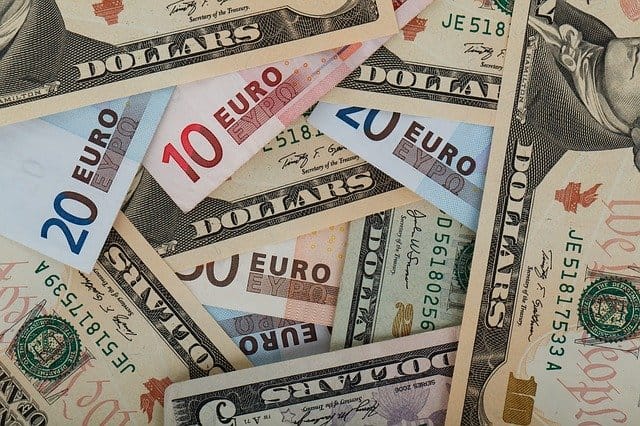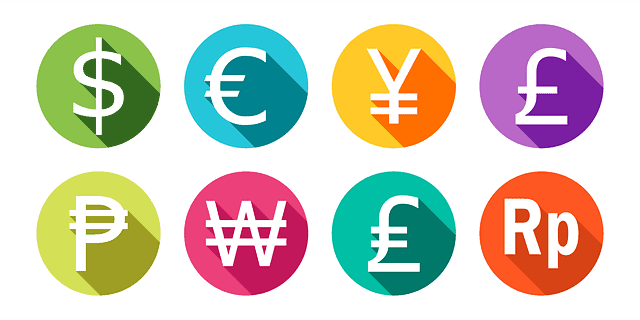How do exchange rates work? Explanation of exchange rates!
When you’re abroad, you often have to exchange one currency for another. Even if you actively trade currencies or Forex, you’ll need to exchange currencies. It’s helpful to understand how an exchange rate works. In this article, I’ll explain in simple terms how exchange rates work.
What is an exchange rate?
The exchange rate indicates the price of a currency. It tells you how much you need to pay for, say, a dollar or a pound. The price of a currency is always displayed in terms of the value of another currency.
How does the exchange rate work?
You can’t display the individual value of one currency. The value of the euro, for example, means nothing on its own. When you go to a currency exchange office, the exchange rate is always displayed in relation to another currency; for example, the euro against the dollar (EUR/USD). This is called a currency pair.
An example of an exchange rate is:
| €1 | $1,50 |
What are currency pairs?
In Forex, you always trade in pairs. A pair indicates the price of one currency in terms of another. With EUR/USD, for example, you’re looking at the amount of dollars you can buy with one euro.
Ratio
A currency pair is always displayed as a ratio. When the EUR/USD rate is 1.20, you get 1.20 dollars for one euro. This means that a laptop that costs 1000 euros will cost 1200 dollars. Any transaction fees are not taken into account, of course.
In the table below, you can see what happens when the euro becomes more valuable in relation to the dollar:
| €1 | $1,5 |
| €1 | $1,6 |
The following happens in this case:
- The euro rate (against the dollar) rises
- The dollar rate (against the euro) falls
Base currency & quote currency
The first currency in the ratio is called the base currency and is always one. The second number is the quote currency and indicates how much of the other currency you’ll get in exchange.
Here’s an example of a quote:
| Base currency | Quote currency |
|---|---|
| €1 | $1,60 |
| €1 | £1,2 |
| €1 | ¥100 |
The quote currency always indicates how much of another currency you can get. The exchange rate constantly fluctuates, which means the quote will change constantly.
What are the current exchange rates?
Do you want to know what the exchange rate is for the euro against the dollar? Or do you want to know what the exchange rate is for the euro against the pound? Use this tool to calculate the current exchange rate:
Currency Converter
|
|
|
|
|
What is a currency markup?
When you physically exchange money at the bank, you always pay an extra markup. Banks are commercially oriented and want to make money. To be able to offer foreign currencies, they need to hold them. They then run the risk of these currencies becoming less valuable. They need to hedge against this risk. Of course, they also have to charge extra to make it possible to operate profitably.
You can see how much the currency markup is by looking at how much the rate deviates from the mid-market rate. This rate is also called the average market rate, middle rate, or interbank exchange rate. This is the rate between the price the bank pays to buy the foreign currency and the price it asks to sell the foreign currency.
Interested in trading currencies yourself?
Would you like to actively trade currencies yourself? You can do this by trading Forex. You then buy and sell currencies with the aim of making a profit.In this guide, you can read in detail how Forex trading works:
Examples of calculating with exchange rates
Do you find exchange rates confusing? We’ll use two small examples to show you how exchange rates work in practice.
Example 1
In the first example, an exchange rate of EUR/USD 1.10 applies. This means that you receive one dollar and ten cents for one euro. You have 1000 euros and want to exchange this for dollars. You will then receive 1100 dollars.
Example 2
In the second example, an exchange rate of EUR/JPY 120 applies. This means that you receive 120 Japanese yen for one euro. You decide to exchange 1000 euros for Japanese yen. In this case, you will receive 12,000 Japanese yen.
How can you make money with the exchange rate?
You can make money with the exchange rate by achieving price gains. You need to buy a currency which becomes more valuable compared to another currency.
In this example, you expect the dollar to become more valuable in relation to the euro. Currently, an exchange rate of EUR/USD 1.1 applies. You buy dollars for €1000 and hence receive $1100.
Then, the value of the dollar rises. As a result, EUR/USD falls to 1. You now exchange your $1100 back for euros. You will now receive €1100 in return. In this example, you would have made a profit of €100.
You can take advantage of the smallest exchange rate fluctuations via the internet. Please note that investing in foreign currencies is risky. When speculating on exchange rates, you can lose money.

What types of exchange rates exist?
There are two types of exchange rates: flexible and fixed exchange rates. Flexible exchange rates fluctuate constantly, while fixed exchange rates hardly ever change.
Flexible exchange rates
Flexible exchange rates fluctuate constantly due to the interplay of supply and demand. The government and central bank do not try to maintain the exchange rate at a fixed value. The policy influences the rate to some extent, but besides this the rate moves freely.
Fixed exchange rates
In some cases, governments want to keep their currency at a fixed value through their central banks. They do this by holding dollar reserves. By selling dollars and buying their currency, the supply of their currency decreases. This causes their currency to increase in value. Governments can manipulate their exchange rates as they wish. An example of such an exchange rate is the Saudi Arabian riyal.
How does the exchange rate move?
On a chart, a rising trend line means that the base currency increases in value and the quote currency decreases in value. For example, with EUR/USD, this means that the value of the euro against the dollar increases. This does not mean that the euro increases in value against all currencies at the same time. The euro can simultaneously lose value against the pound.
On a falling trend line, the base currency decreases in value and the quote currency increases in value. Keep in mind that a decrease in EUR/USD does not necessarily mean that EUR/GBP will also decrease; the opposite may be the case!
What influences the exchange rate?
The exchange rate of Forex is entirely influenced by the interplay of supply and demand. In fact, the exchange rate of currencies is not much different from the stock price of, for example, a share:
- When the supply of a particular currency increases, the value of that currency decreases.
- When the demand for a particular currency increases, the value of that currency increases.
What factors influence the exchange rate?
The value of a currency is determined by the interplay of supply and demand. On a larger scale, these factors play an important role in the exchange rate of a currency.
Factor 1: Economic situation in the region
Economic prosperity in a region often leads to an increase in the value of a currency. For example, when the US economy performs well, more products are purchased. People do this in the local currency and therefore have to buy dollars. This can cause the dollar to increase in value against, for example, the euro.
Factor 2: Interest rates
The interest rate also has a big influence on the exchange rate. When trading in Forex, it is critical to stay alert to announcements from Central Banks regarding interest rates. When interest rates rise, the demand for the currency typically increases. For example, if the ECB (European Central Bank) raises interest rates, there is a good chance that the euro will increase in value against the dollar.
Factor 3: money supply
The supply of a currency also affects the exchange rate. When a Central Bank prints a lot of money, the supply increases, which causes the exchange rate to drop. If too much money is printed, inflation can even occur.
Therefore, the exchange rate is 100% linked to the forces of supply and demand. If you want to be successful in investing in Forex, you will need to analyse the forces behind supply and demand.
Calculating pips in Forex
In the vast majority of currency pairs, a pip is the fourth digit after the decimal point. For example, if you read the EUR/GBP rate as 1.1234, the fourth digit, or 0.0004, is the current pip value. When the rate rises to 1.1235, it has moved by one pip, and when it rises to 1.1244, it has risen by 10 pips.
The big exception to this rule is the Japanese yen. In yen exchange rates, the second digit after the decimal point indicates the pip value. For example, in the EUR/JPY rate of 123.86, 0.01 is one pip value, and a rise to 124 would represent an increase of 14 pips.
Pips are used in Forex to easily compare different profits and losses. You can then compare the results of Forex investors neutrally. Do you want to know more about pips? Then read the article about pips:
How does the exchange rate affect your daily life?
The exchange rate of your currency has a big impact on your daily life. You will notice this when you travel to another country. When your currency is strong, you get more value for your money, and vacations become a lot cheaper.
The exchange rate also has many indirect effects. When your currency becomes less valuable, foreign products become pricier which can cause your purchasing power to decrease.
Frequently asked questions about exchange rates
You can exchange currency at a so-called ‘exchange’. You can exchange your euros for foreign currencies, for example at the airport or the bank. Nowadays, you can also exchange currencies via the internet: I use Revolut for this. A big advantage of this is that you don’t pay any extra fees for exchanging currencies.
You can exchange unlimited amounts of money, as long as it is obtained legally. In many governments, you are obliged to show your identification when you exchange money to ensure you obtained the funds legally.
A currency exchange office is a company where you can exchange currencies. For example, you can exchange euros for dollars in such an office.
Every organization can set its exchange rate. The interbank exchange rate is the exchange rate that banks charge each other. Some currency exchange offices offer less attractive rates. Therefore, make sure to verify if the rate you are offered is correct.
Auteur

Over Alex Mostert
When I was 16, I secretly bought my first stock. Since that ‘proud moment’ I have been managing trading.info for over 10 years. It is my goal to educate people about financial freedom. After my studies business administration and psychology, I decided to put all my time in developing this website. Since I love to travel, I work from all over the world. Click here to read more about trading.info! Don’t hesitate to leave a comment under this article.

